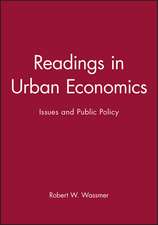Lords and Towns in Medieval Europe: The European Historic Towns Atlas Project
Editat de Howard B. Clarke, Anngret Simmsen Limba Engleză Hardback – 28 sep 2015
Preț: 864.65 lei
Preț vechi: 1150.38 lei
-25% Nou
Puncte Express: 1297
Preț estimativ în valută:
165.45€ • 173.10$ • 137.44£
165.45€ • 173.10$ • 137.44£
Carte tipărită la comandă
Livrare economică 02-16 aprilie
Preluare comenzi: 021 569.72.76
Specificații
ISBN-13: 9780754663546
ISBN-10: 075466354X
Pagini: 574
Ilustrații: Includes 116 b&w illustrations
Dimensiuni: 174 x 246 x 45 mm
Greutate: 1.39 kg
Ediția:New ed
Editura: Taylor & Francis
Colecția Routledge
Locul publicării:Oxford, United Kingdom
ISBN-10: 075466354X
Pagini: 574
Ilustrații: Includes 116 b&w illustrations
Dimensiuni: 174 x 246 x 45 mm
Greutate: 1.39 kg
Ediția:New ed
Editura: Taylor & Francis
Colecția Routledge
Locul publicării:Oxford, United Kingdom
Cuprins
Contents: Ferdinand Opll: an appreciation; Introduction, Anngret Simms and Howard B. Clarke. Part I The Challenge of Comparative Urban Studies: The European historic towns atlas project: origin and potential, Anngret Simms; Comparative approaches in the historico-topographical analysis of towns and cities, Dietrich Denecke. Part II Case Studies from a National Perspective in the Core Area of Medieval Europe: The topography of power in the towns of medieval Italy, Francesca Bocchi ; The Atlas historique de Bordeaux: a newcomer to the series Atlas historique des villes de France, Sandrine Lavaud; Reinventing the German towns atlas? Trends in the development of a national historic towns atlas project, Daniel Stracke and Thomas Tippach; Seigneurial power and the development of towns in the Holy Roman Empire, Peter Johanek; The king and ’his’ town of Litoměřice/Leitmeritz in medieval Bohemia, Josef ZemliÄka; Seigneurial power and planning: aspects of the origins of towns in Austria with particular reference to Vienna and Wiener Neustadt, Ferdinand Opll; Town planning in the 12th and 13th centuries: symbolic meaning and pragmatic process, Martina Stercken; Lordship, economy and society in English medieval marketplaces, Terry R. Slater. Part III Case Studies from a National Perspective on the Periphery of Medieval Europe: Polish town plans as expressions of political and economic power, Roman Czaja; Royal power and urban space in medieval Hungary, Katalin Szende and András Végh; Medieval town plans in Romania, Paul Niedermaier; The medieval planned town in Croatia, Mirela Slukan Alti; Planning and regulation in the formation of new towns and new quarters in Ireland, 1170-1641, Howard B. Clarke; Town plans as expressions of political and economic power and ecclesiastical organization in Scandinavia, Marjatta Hietala. Part IV Symbolic Meanings of Town Plans: Medieval urban form in the Low Countries: state of research, comparative perspective and symbolic meanin
Notă biografică
Anngret Simms is Professor Emeritus of Historical Geography at University College, Dublin and a member of the Royal Irish Academy. She has been a joint editor of the Irish Historic Towns Atlas from its very beginnings. She is one of the conveners of the atlas working group of the International Commission for the History of Towns.
Howard Clarke is Professor Emeritus of Medieval Socio-Economic History at University College, Dublin. He has long been an editor of the Irish Historic Towns Atlas and is the author of the fascicle for medieval Dublin. He is a member and former academic secretary of the Royal Irish Academy. He is also a member of the International Commission for the History of Towns.
Howard Clarke is Professor Emeritus of Medieval Socio-Economic History at University College, Dublin. He has long been an editor of the Irish Historic Towns Atlas and is the author of the fascicle for medieval Dublin. He is a member and former academic secretary of the Royal Irish Academy. He is also a member of the International Commission for the History of Towns.
Recenzii
"Created "in a spirit of reconciliation after the destruction of European towns during the Second World War," the International Commission for the History of Towns emerged in 1953 to study the rise and development of urban centers from the post-Roman period to more recent times. This volume begins to unite material from the over 500 national atlases currently produced. Although the title and introductory matter stress the role of seigneurial power, the essays take a more functional approach. Summing Up: Recommended."
- L. C. Attreed, College of the Holy Cross, CHOICE
"Overall, this monumental work captures the rewards and the challenges of comparative, coordinated, pan-European scholarship."
- Mark Bailey, University of East Anglia
"...one is full of admiration for the arduous editorial work invested in this book by Anngret Simms and Howard Clarke, and we can be inspired by some of the essays that depart from the rather traditional central theme, by Keith Lilley, Derek Keene, and Jürgen Paul for example, which explore the cultural background, the ideas behind medieval town planning, and the symbolism that can be detected in urban forms."
- Christopher Dyer, University of Leicester, UK
"This book is a welcome introduction to the richness of urban settlement across Europe and the role of effective historic mapping in managing the urban future."
- Brian Ayers, University of East Anglia, UK
- L. C. Attreed, College of the Holy Cross, CHOICE
"Overall, this monumental work captures the rewards and the challenges of comparative, coordinated, pan-European scholarship."
- Mark Bailey, University of East Anglia
"...one is full of admiration for the arduous editorial work invested in this book by Anngret Simms and Howard Clarke, and we can be inspired by some of the essays that depart from the rather traditional central theme, by Keith Lilley, Derek Keene, and Jürgen Paul for example, which explore the cultural background, the ideas behind medieval town planning, and the symbolism that can be detected in urban forms."
- Christopher Dyer, University of Leicester, UK
"This book is a welcome introduction to the richness of urban settlement across Europe and the role of effective historic mapping in managing the urban future."
- Brian Ayers, University of East Anglia, UK
Descriere
This volume is the first publication to draw upon the mass of information provided by the Historic Towns Atlases in order to explore comparative questions in medieval urban history. The volume addresses the wider question of comparative urban studies, the processes that determined the morphological formation of towns, and the symbolic meaning of large-scale town plans in their cultural context.














